

Neurosculpting for Anxiety. Neurosculpting is a relatively new therapy.
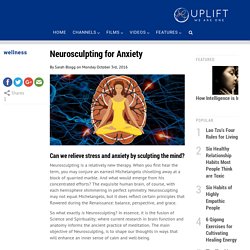
When you first hear the term, you may conjure an earnest Michelangelo chiselling away at a block of quarried marble. And what would emerge from his concentrated efforts? The exquisite human brain, of course, with each hemisphere shimmering in perfect symmetry. Neurosculpting may not equal Michelangelo, but it does reflect certain principles that flowered during the Renaissance: balance, perspective, and grace. So what exactly is Neurosculpting? Can we shape our thoughts? This healing modality was founded ten years ago by Lisa Wimberg who refined the process by helping people in high-pressure jobs such as: firefighters, first aid responders, and police officers.
Anxiety and Neurosculpting When you feel anxious, it seems impossible to appreciate anything: a smile, a sunset or your child’s latest Biology project. Brain scans have shown that children inherit anxiety Restoring Harmony in the Brain Anxiety can motivate us to solve problems. 2 Simple Buddhist Techniques for Amplifying Positive Feelings and Softening Negative Moods. In this article, I’m going to share two powerful, little-known Eastern techniques to help you amplify emotional highs and keep warm when you’re feeling blue.
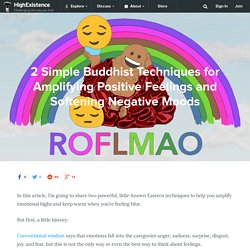
But first, a little history: Conventional wisdom says that emotions fall into the categories anger, sadness, surprise, disgust, joy, and fear, but this is not the only way or even the best way to think about feelings. Emotions do not arise in isolation and without context. We feel things in relation to other things. We feel pleasure in relation to a nice meal or great conversation. Emotions self-perpetuate: when we feel great, we feel great that we feel great; when we feel sad, we feel sad that we feel sad. In order to make sense of this emotional cobweb, 2,000 years ago an incomparably wise Indian man called Siddhartha Gautama — his friends called him Buddha — came up with two helpful ways to think about our relationship with feelings:
The Practical Steps to Enlightenment: Vinay Gupta Interview. Podcast: Play in new window | Download This is part 4 of our interviews with Vinay Gupta, and the second portion of our talk on enlightenment.

I recommend that you listen to the first portion of the enlightenment talk before this one, and the last one on enlightenment for the future of humanity after. Also check out our interview with Vinay from last year, where we discussed Ethereum, space colonization, and a whole bunch of other fascinating things. The Neurobiology of Grace Under Pressure. How to Release the Stress stored in our Bodies. Do you spend much time sitting in front of a computer, on a plane, in a car?

If so your hips may be locked up which effects your ability to dance, but worse than that it may be causing you undue stress and fear. The Psoas Muscle, is a long muscle located on the side of the lumbar region of the vertebral column and brim of the pelvis, that is also known as the “muscle of the soul”. It is one of the largest muscles in the body and it is a place where we often store stress or trauma that can literally influence our mood and our outlook on life. We recently explored in depth just how much fear can inhibit our ability to think clearly thus creating an unhealthy perspective that can harm us and those around us.
Now let’s look at where that fear might be stored in our body, and a few ways to release it. Ted Hughes on How to Be a Writer: A Letter of Advice to His 18-Year-Old Daughter. “Read good books, have good sentences in your ears,” the poet Jane Kenyon counseled in what remains some of the sagest advice to write and live by.
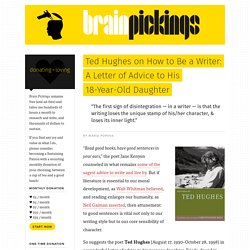
But if literature is essential to our moral development, as Walt Whitman believed, and reading enlarges our humanity, as Neil Gaiman asserted, then attunement to good sentences is vital not only to our writing style but to our core sensibility of character. So suggests the poet Ted Hughes (August 17, 1930–October 28, 1998) in a wonderful letter of advice to his teenage daughter, Frieda, found in Letters of Ted Hughes (public library) — the same volume that gave us Hughes’s immensely moving letter to his son about nurturing the universal inner child. Frieda had been half-orphaned at the age of three when her mother, Sylvia Plath, died by suicide. Hughes was left to raise the couple’s two children, for whom Plath had written her only children’s books. Transform Your Relationships By Shifting Your Mindset. Here's How. Whatever the impetus for your resolutions, most of us fail in our attempts to create sustainable change.
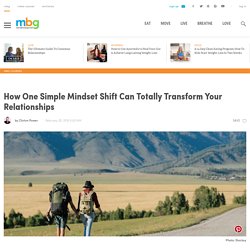
Change is hard. It’s uncomfortable and it takes incredible persistence, perseverance, and patience — qualities many of us struggle to cultivate. As a relationship therapist, I'm always thinking about the changes I want to make in my relationships and trying to encourage and support changes my clients want to make in their relationships. But instead of committing to relationship resolutions that may never stick, I want to invite you to use “relationship theme” instead. What is a relationship theme? Mortisville's profile. Fizuxed. Soul, Community and Social Change by Peter Westoby. At a time when inequalities are growing globally, when the pace of socio-economic transitions is rapid, and when traditional ties of community are under threat of dissolving, ‘soul’ offers a new way of thinking imaginatively about how people might respond both individually and collectively in social change work.In exploring ideas such as soul, soulful, ‘soul of the world’ and soul-force, Peter Westoby invites readers to disrupt their taken-for-granted assumptions about community practice and to foreground ethics, quality, being and the aesthetic.

Drawing on work of people such as James Hillman, Thomas Moore and 'Bifo' Beradi, he insists on the need to bring more depth into practice, eschewing contemporary trends of soulless analysis, measuring, and technique.Written in dialogue with eight practitioner-scholars from around the world, the book suggests a fresh terrain for community work and social change theorising. Feeling Overwhelmed? Remember "RAIN" When I was in college, I went off to the mountains for a weekend of hiking with an older, wiser friend of twenty-two.

The Health Dangers of Practicing Detachment in Relationships. In the modern world of spirituality and conscious relationships, detachment is considered to be one of the fundamental pillars of conscious living and loving.
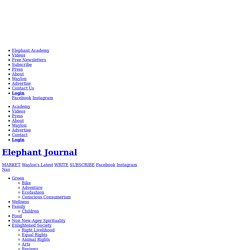
The concept of detachment comes from Hindu and Buddhist spirituality. Deep listening (dadirri) Deep listening explained Deep listening means also contemplation. Sometimes called ‘dadirri’ it’s a concept not exclusive to Aboriginal people. Photo: Julia-Freeman-Woolpert, sxc.hu. Domains of Knowledge. These Domains of Knowledge – which inverted to become known as the Flame model and which expand the Iceberg – come straight from my lacing with dialogos and submersion into the waters of collective intelligence.
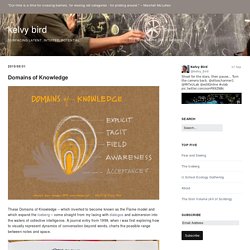
A journal entry from 1999, when i was first exploring how to visually represent dynamics of conversation beyond words, charts the possible range between notes and space. This sharing, in a circle of about 30 dialogue practitioners, spoke to identifying “forces at play” that inform facilitative moves, or gestures. The domains stretch between the explicit (behavioral) and the implicate (awareness-based) orders, and indicate the importance of attending to all domains simultaneously. It is not a scale; rather, it’s meant as a tiered echo from inner attunement. Explicit This is the tip of the Iceberg: events, what we notice objectively. Tacit. UnconsciousBias. What is Meditation / Mindfulness Good for? Dan Harris: Hack Your Brain's Default Mode with Meditation. Why You Need Boredom, Distraction, and Procrastination in Your Life. All the Benefits of Meditation and Mindfulness According to Science. Authenticity and the Generative Self 2015 « Presented by Alderlore Insight Center.
18 Spiritual Teachings that Blew my Mind Wide Open. After rejecting the Catholic Church around age 10, I stumbled upon the love of my life—yoga-—at the critical age of 12-going-on-13. I started reading New Age self-help books in college and met the Buddha in the San Francisco Bay area at 23. Each stage along the way has been illuminating and necessary to move to a higher level of consciousness. I am thrilled to continue learning and practicing throughout this lifetime, at least. At certain points in the past, I have wished for epiphanies, signals and sudden enlightenment. Harvard Study Unveils What Meditation Literally Does To The Brain. Sam Harris on the Paradox of Meditation and How to Stretch Our Capacity for Everyday Self-Transcendence. Montaigne believed that meditation is the finest exercise of one’s mind and David Lynch uses it as an anchor of his creative integrity. Over the centuries, the ancient Eastern practice has had a variety of exports and permutations in the West, but at no point has it been more vital to our sanity and psychoemotional survival than amidst our current epidemic of hurrying and cult of productivity.
It is remarkable how much we, as a culture, invest in the fitness of the body and how little, by and large, in the fitness of the spirit and the psyche — which is essentially what meditation provides. In Waking Up: A Guide to Spirituality Without Religion (public library), neuroscientist and philosopher Sam Harris argued that cultivating the art of presence is our greatest gateway to true happiness. Harris writes: How We Spend Our Days Is How We Spend Our Lives: Annie Dillard on Presence Over Productivity. By Maria Popova “The life of sensation is the life of greed; it requires more and more. The life of the spirit requires less and less.” The meaning of life has been pondered by such literary icons as Leo Tolstoy (1904), Henry Miller (1918), Anaïs Nin (1946), Viktor Frankl (1946), Italo Calvino (1975), and David Foster Wallace (2005).
The Art of Timing: Alan Watts on the Perils of Hurrying and the Pleasures of Presence. This Video Shows How to Start Teaching Your Kids to Meditate. Do Not Despise Your Inner World: Advice on a Full Life from Philosopher Martha Nussbaum. The video that changed everything I thought I know about non-attachement. {Video} The Heart of Non-Attachment True non-attachment is an intimacy with life.
A Lesson in Listening from John Cage. Sam Harris on Spirituality without Religion, Happiness, and How to Cultivate the Art of Presence. 5 Ways To Love The Present No Matter How Scared You Are. Recently, a small black mole appeared on my ankle. I had a sinking feeling when I saw it. A biopsy and a personal call from the doctor confirmed that the spot was indeed cause for concern and I would need surgery to remove a larger section of the surrounding tissue.
I got the news the day before I left to lead a weeklong yoga retreat in Maui. I wouldn’t be able to practice yoga for at least three weeks after the procedure, so the doc told me to enjoy my vacation and we would schedule surgery when I got back. This Is Your Body On Meditation (Infographic) John Searle: Our shared condition. Mindfulness: more than a fad, less than a revolution. 18 Fantastic Ways to Let Go. Letting go is the ultimate zen habit we all must master, sooner or later. Mihaly Csikszentmihalyi: Flow, the secret to happiness. 7 Life-Learnings from 7 Years of Brain Pickings, Illustrated. By Maria Popova. Why Crafting Is Great For Your Brain: A Neuroscientist Explains. Knit one. Be Like Water: The Philosophy and Origin of Bruce Lee’s Famous Metaphor for Resilience. Remember “RAIN” When You Feel Overwhelmed.
How To Rest Your Mind. ~ Rose Taylor Goldfield. Indian teachers of yoga say that the Corpse Pose is the hardest yoga pose for Westerners. In Corpse Pose, we lie on the floor and surrender to the earth, leaving the body in perfect rest and stillness as though dead. Trying Not to Try: How to Cultivate the Paradoxical Art of Spontaneity Through the Chinese Concept of Wu-Wei. By Maria Popova. Lift's Guide to Meditation Is a Data-Driven Introduction for Beginners. 3 Things Mindfulness is Not. ~ Ruth Lera. Via Ruth Leraon Apr 18, 2014. Banned TED Talk: Graham Hancock – The War on Consciousness. Yet another TED talk banned by the TED community due to the challenge it poses to mainstream science. How To Get Free Of Attachment. Susan Cain: The power of introverts.
Learn to Speak a New Language Fluently in Six Months. Debunking the Myth of the 10,000-Hours Rule: What It Actually Takes to Reach Genius-Level Excellence. How You Can Learn to Finally, Really Relax. Four Ways Mindfulness Can Make You a More Successful Entrepreneur The Science of Humor and the Humor of Science: A Brilliant 1969 Reflection on Laughter as Self-Defense Against Automation.
14 Benefits of Mindfulness (& How It Works). {Infographic} The Art of Looking: How to Live with Presence, Break the Tyranny of Productivity, and Learn to See Our Everyday Wonderland. Geometrical Psychology: Benjamin Betts’s 19th-Century Mathematical Illustrations of Consciousness. How Thinking Ahead Can Actually Still and Help the Mind. David Lynch on Using Meditation as an Anchor of Creativity & Integrity. Presence, Not Praise: How To Cultivate a Healthy Relationship with Achievement. An Antidote to the Age of Anxiety: Alan Watts on Happiness and How to Live with Presence. What Everyone Needs To Know About Their Chakras. Why Don't You Try This?: According To Scientists, This Is The Most Relaxing Tune Ever Recorded. Change Your Entire Life With This Simple Technique From Thich Nhat Hanh. It’s Kind Of Amazing! Theconversation. Want some meditation along with that meeting? Harvard Yoga Scientists Find Proof of Meditation Benefit.
How Mindfulness Helps You See What's Missing (And Why You'd Want To) 5 steps to calm your mind and increase creativity. How Mindfulness Cultivates Compassion. 4 scientific studies on how meditation can affect your heart and brain. "When people start to meditate or to work with any kind of spiritual discipline, they often think that somehow they're going to improve." ~ Pema Chodron.
How Meditation Changes Your Brain Frequency. The Art of Looking: What 11 Experts Teach Us about Seeing Our Familiar City Block with New Eyes. If You Only Do 10 Yoga Poses, Do These. Real Yoga.